Curiosity rover: 2,000 days on Mars
- Published
Nasa's Curiosity rover, also known as the Mars Science Laboratory (MSL), is celebrating 2,000 martian days (sols) investigating Gale Crater on the Red Planet. In that time, the robot has made some remarkable observations. Here are just a few of them, chosen by the Curiosity science team, external.

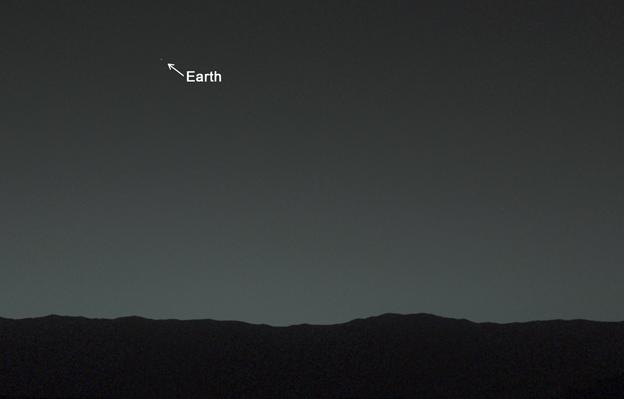
Looking back: In the history of the space age, some of the most dramatic planetary images ever taken have been of Earth, but photographed looking back from deep space. This image by Mastcam on the Curiosity Rover shows our planet as a faint pinpoint of light in the martian night sky. Every day scientists from across the world drive the Curiosity rover and study the Red Planet about 100 million miles from Earth.

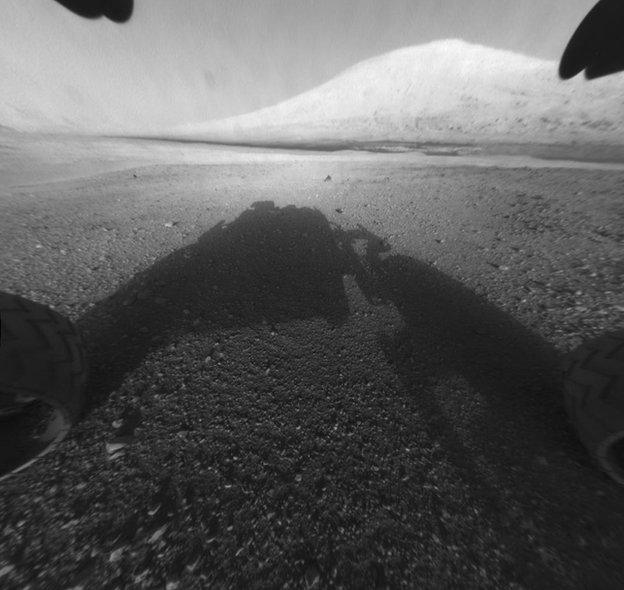
The beginning: The first image that Curiosity took came back just 15 minutes after landing on 5 August 2012. Getting our imagery and other data relies on the timing of Mars Reconnaissance Orbiter (MRO) overpasses, a pattern which determines the structure of the martian working day, or sol. It shows a grainy Front Hazard Camera image - the team normally use these to help avoid obstacles - of our ultimate goal Mount Sharp. When this image came back we knew it was going to be a successful mission.

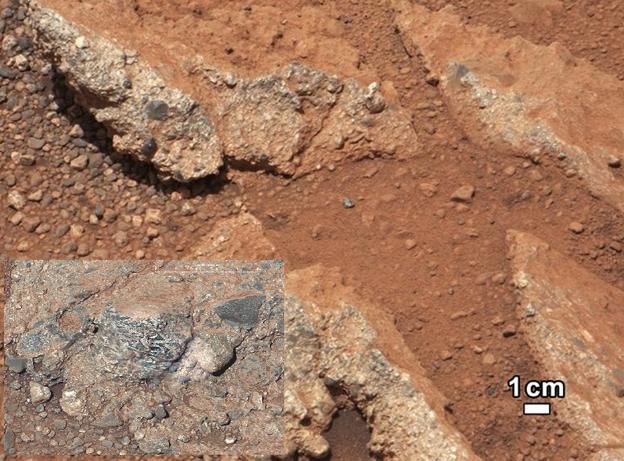
River pebbles: Once we had started driving (16 sols after landing), we soon came across these pebble beds. The rounded shape of the clasts shows that they formed in an ancient, shallow river, flowing from the surrounding four-billion-year-old highlands into Gale Crater. The inset Mastcam image shows one of the pebbles in close-up. Contrary to our expectations before MSL, the crust being eroded by the rivers was not all dark, primitive basalt but a more evolved composition and mineralogy. Pebbles caught up in this ancient martian river are causing us to rethink our view of how the underlying igneous crust and mantle of Mars formed.

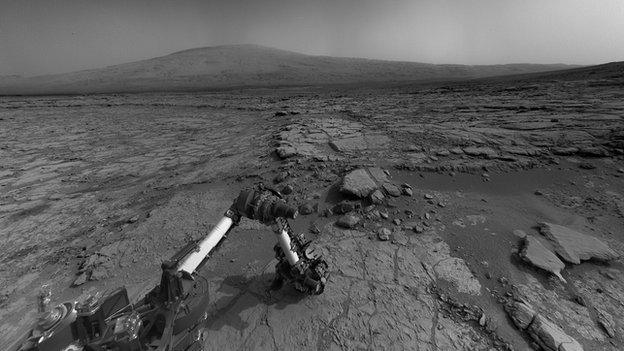
Ancient lake: Before landing and in the early part of the mission, the team wasn't sure what all of the terrains identified from MRO HiRISE orbital imagery were. They might have been lava flows or lake sediments, without close-up "ground truth" it was impossible to be certain. This image settled the debate and was a seminal stage in Martian exploration. Yellowknife Bay is made of layers of fine grained sand and muds, which were deposited as rivers flowed into an ancient Gale Crater lake. We made our first of 16 drill holes on sol 182 - we do this to get rock in to the spectrometers housed in the body of our rover - here at the John Klein site. The results - including identifying clays, organics and nitrogen-bearing compounds - showed us that this had been a habitable environment for microbial life. The next discovery step - Was There Life? - remains to be determined.


Deep water: The Pahrump Hills section Curiosity encountered around sol 753 was key for developing our understanding of Gale's past environment. Here the rover observed thinly layered mudstones, which represented mud particles settling out from suspension within the deeper lake. The Gale Lake has been a long-standing, deep body of water.


An unconformity: At Mount Stimson, the rover identified from sol 980 a thick sandstone unit overlying the lake deposits, separated by a geological feature called an unconformity. This unconformity represents a time where erosive processes took over after millions of years when the lake had finally dried up - to form a new land surface. This shows evidence of events happening over "deep time", similar to those that the pioneering geologist James Hutton described in his field work in the late 18th Century at Siccar Point on the Scottish Coast.


Desert sands: The Namib dunes encountered close up by Curiosity at sol 1192 is a small part of the great Bagnold dune field. Its the first active dunefield explored on the surface of another planet and Curiosity had to pick its way carefully along and through the field as moving sands are an obstacle for rovers. Although the Martian atmosphere is a fraction of the density of that of Earth's, it is still capable of transporting sediment and is capable of creating such beautiful structures akin to those we see in the deserts of Earth.


Wind sculptures: The Murray Buttes, photographed by Mastcam on sol 1448, formed of the same sandstones observed at Mount Stimson and represent a lithified dune field created by dunes similar to those in the present day Bagnold dune field. These desert-formed sandstones sit above an unconformity, and this suggests that after a long period with a humid climate, the climate became drier and wind became the dominant agent shaping the environment at Gale Crater.

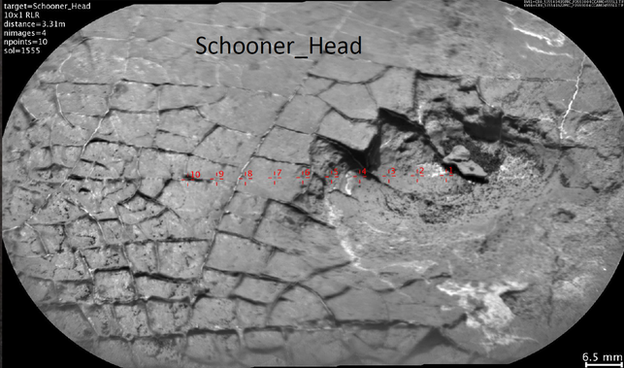
Dried muds: Curiosity is able to perform detailed analyses of the Gale rocks with the ChemCam laser and telescope mounted on its mast. Here on sol 1555 at Schooner Head we came across a set of ancient mudcracks and sulphate veins. On Earth, lakes typically dry up in places around their margins and here on Mars the Gale lake was no different. You can see the red crosses where we fired the laser at the rock, creating a small plasma spark, with the wavelength of light in the spark telling us the composition of the mudstone and veins.

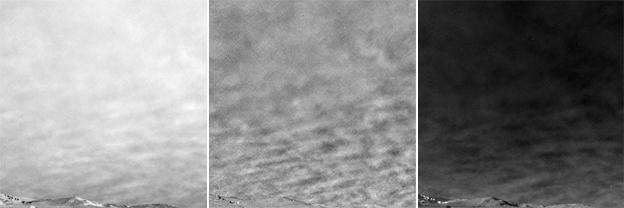
Cloudy skies: This sequence of images was taken with Curiosity's Navigational Cameras (NavCam) on sol 1971 as we pointed them towards the sky. Occasionally on the cloudiest of Martian days we are able to make out faint clouds in the sky. These images are processed to highlight differences, allowing us to see the clouds move across the sky. This sequence shows previously unseen cloud features with prominent zig-zag patterns visible. The three images, from start to finish, cover approximately 12 minutes on Mars.

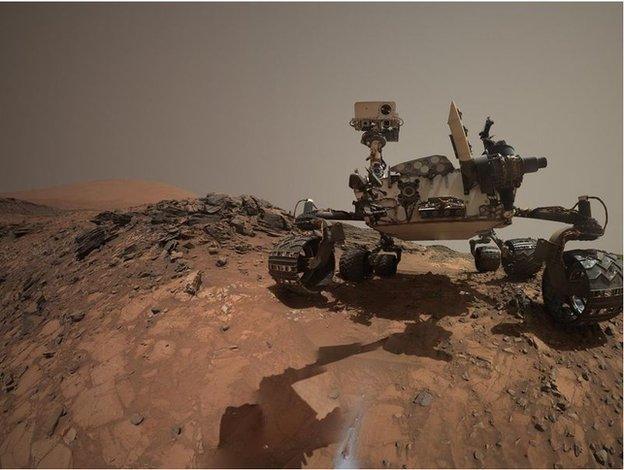
Obligatory 'selfie': The Curiosity rover has gained a reputation over the years that rivals those of Instagram users for its many "selfies" taken along its traverse. These selfies are not all for show though as they help the team track the state of the rover throughout the course of the mission for changes such as wheel wear and dust accumulation. Curiosity's self-portraits are taken using the rover's Mars Hand Lens Imager (MAHLI) situated on its robotic arm and are generated by merging a series of high-resolution images into a mosaic. This one taken on sol 1065 at the Buckskin locality shows the main mast of Curiosity with its ChemCam telescope used to determine rock compositions, and the Mastcam cameras. In the foreground you can see that Curiosity has just been drilling, leaving a small grey pile of tailings.

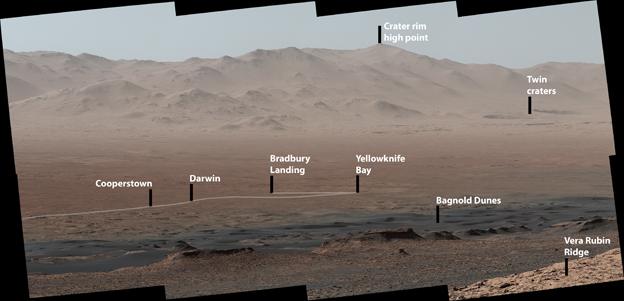
Long drive: This panorama taken with the rover's Mastcam shows Curiosity's 18.4km drive over the last 5 years from the Bradbury landing site to its current location on the Vera Rubin Ridge (VRR). VRR was formerly known as Hematite Ridge due to the high concentrations of the iron oxide mineral hematite detected here from orbit. As hematite largely forms in the presence of water, this location was a high-priority target for the Curiosity rover science team to investigate in order to assess how the conditions in Gale Crater changed over its geological history. This key location is the perfect spot for Curiosity to spend its 2000th sol, and for all of us to look back on the many discoveries made so far in the mission.

By John Bridges, Ashwin Vasavada, Susanne Schwenzer, Sanjeev Gupta, Steve Banham, Candice Bedford, Christina Smith, Brittney Cooper & the MSL Team